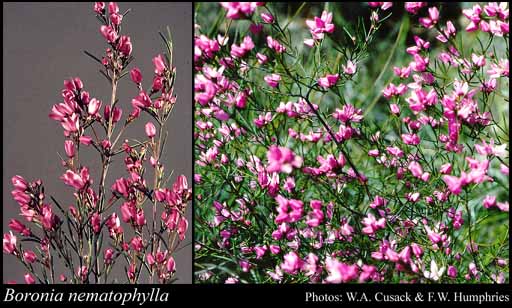- Reference
- Fragm. (Mueller) 2:100 (1860)
- Conservation Code
- Not threatened
- Naturalised Status
- Native to Western Australia
- Name Status
- Current
Slender shrub, 0.3-1 m high. Fl. red-pink, Apr to Dec. Sandy soils. Dunes, sandplains.

Scientific Description
Shrub, spines absent; branchlets smooth, without distinct raised glands, +/- cylindrical in cross-section, glabrous. Leaves opposite, simple, 9-30 mm long, 0.8-1 mm wide, flat, the margins revolute, smooth, without distinct raised glands, covered in hairs or scales or glabrous, with stellate (star shaped) hairs; stipular excrescences absent. Flowers axillary, solitary or terminal. solitary; pedicels 5-6 mm long; calyx present, 2-3 mm long, smooth, without distinct raised glands, glabrous; corolla red or pink, petals four, 8-11 mm long, imbricate (overlapping), free, glabrous; stamens twice as many as petals, 4-4.3 mm long, smooth, ciliate (with a marginal fringe of hairs); anthers 0.8-1 mm long, with an appendage. Flowers in April, May, June, July, August, September, October, November and December. Occurs in the South-West Botanical Province, in the Avon Wheatbelt, Jarrah Forest, Mallee, Warren and Esperance IBRA region(s).
Distribution
- IBRA Regions
- Avon Wheatbelt, Esperance Plains, Jarrah Forest, Mallee, Warren.
- IBRA Subregions
- Fitzgerald, Katanning, Southern Jarrah Forest, Warren, Western Mallee.
- Local Government Areas (LGAs)
- Albany, Boyup Brook, Broomehill-Tambellup, Collie, Cranbrook, Denmark, Dumbleyung, Gnowangerup, Jerramungup, Manjimup, Plantagenet, Ravensthorpe, West Arthur.